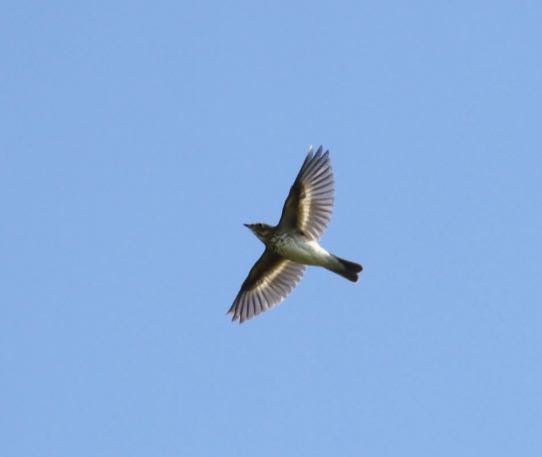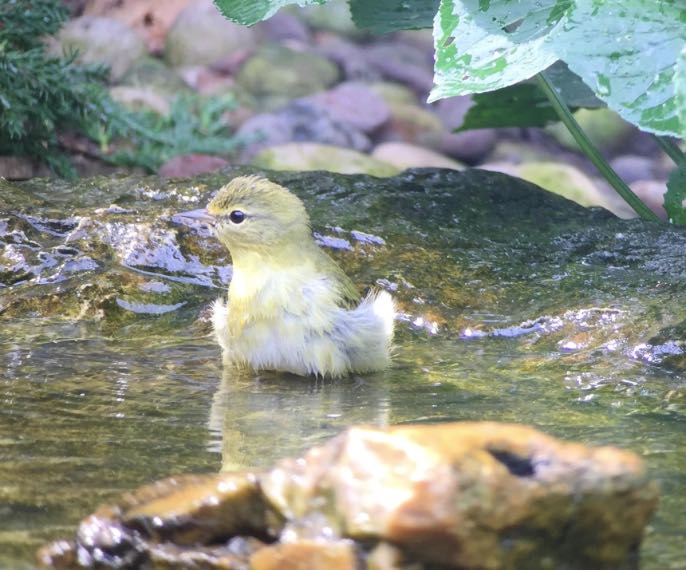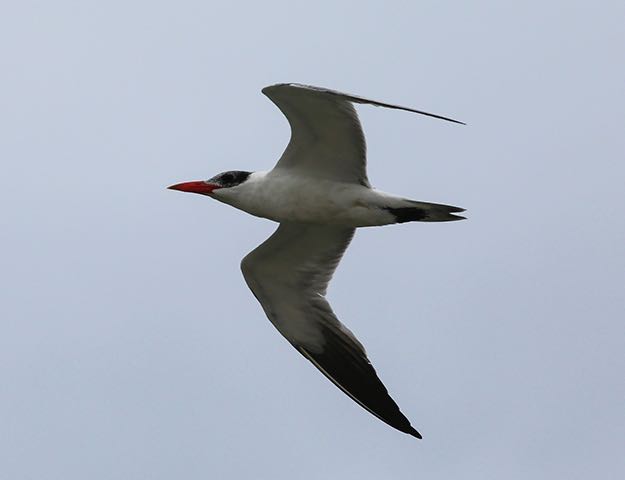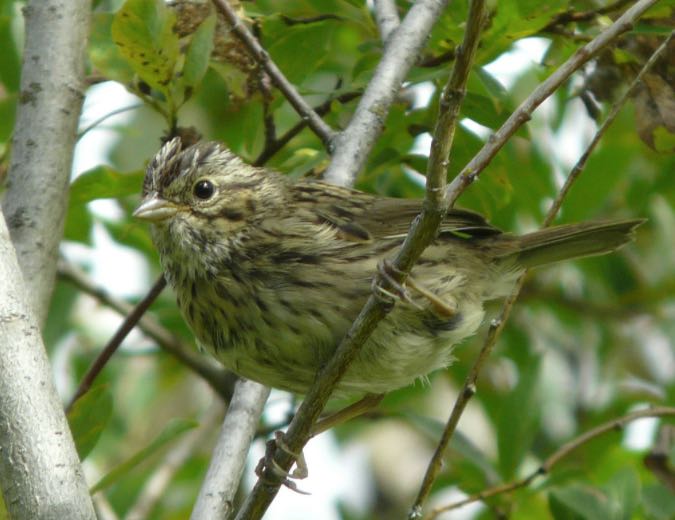Continental Summary
A busy week of migration across the nation featured light to moderate movements in the West and moderate to heavy flights in the East, with Northern Pintail, Caspian Tern, Swanson’s Thrush, Tennessee Warbler, Nashville Warbler, Magnolia Warbler, Baltimore Oriole, and Lincoln’s Sparrow on the move.
Curious what birds will move next? Check out our migration forecast.
Need a review of our definitions for regions, species on the move, and migration amounts? Please visit this link.
Quick Links to Regions
Upper Midwest and Northeast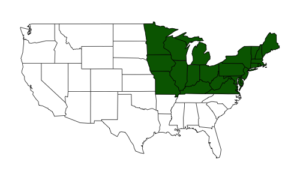 |
Gulf Coast and Southeast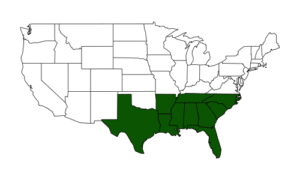 |
Great Plains |
West |
Upper Midwest and Northeast
Several significant movements occurred during this forecast period, including widespread moderate to locally heavy flights on Friday, Monday, and Thursday nights. In addition, the Upper Midwest experienced some heavy to locally very heavy flights on Monday and Tuesday night, particularly in the western Great Lakes. These movements were associated with the passage of several smaller disturbances and a frontal boundary, and generally conditions for flights were marginal to highly favorable for migration in many areas.
Top Movers
Increasing
| Species | Increase from Last Week | % of Checklists Reporting |
|---|---|---|
| Magnolia Warbler | 132% | 7.4 |
| Swainson's Thrush | 331% | 3.4 |
| Blackpoll Warbler | 311% | 2.6 |
| Bay-breasted Warbler | 386% | 1.9 |
| Warbling Vireo | 43% | 8.2 |
| Black-throated Green Warbler | 79% | 4.1 |
| American Redstart | 34% | 14.1 |
| Northern Parula | 135% | 2.4 |
| Tennessee Warbler | 62% | 4.4 |
| Black-throated Blue Warbler | 102% | 1.9 |
| Cape May Warbler | 141% | 1.6 |
| Wilson's Warbler | 81% | 1.9 |
| Philadelphia Vireo | 130% | 1.2 |
| Palm Warbler | 256% | 0.9 |
| Nashville Warbler | 46% | 3.4 |
| American Golden-Plover | 84% | 1.7 |
| White-breasted Nuthatch | 19% | 34 |
| Red-bellied Woodpecker | 22% | 25.3 |
| Yellow-throated Vireo | 43% | 2.9 |
| Blackburnian Warbler | 43% | 3.3 |
| Red-breasted Nuthatch | 22% | 8.2 |
| Killdeer | 17% | 21.2 |
| Ovenbird | 31% | 3.2 |
| Blue Jay | 11% | 49.6 |
Decreasing
| Species | Decrease from Last Week | % of Checklists Reporting |
|---|---|---|
| Eastern Kingbird | -50% | 7 |
| Bank Swallow | -43% | 2.3 |
| Barn Swallow | -36% | 18.7 |
| Purple Martin | -41% | 2.8 |
| Baltimore Oriole | -34% | 8.6 |
| Black Tern | -48% | 1 |
| Tricolored Heron | -65% | 0.3 |
| Tree Swallow | -25% | 13.8 |
| Yellow Warbler | -33% | 3 |
| Indigo Bunting | -27% | 5.5 |
| Glossy Ibis | -49% | 0.6 |
| Northern Rough-winged Swallow | -26% | 2.9 |
| Blue-gray Gnatcatcher | -19% | 7.7 |
| Cliff Swallow | -30% | 1.6 |
| Yellow-billed Cuckoo | -24% | 3.4 |
| Short-billed Dowitcher | -24% | 3.7 |
| Least Tern | -38% | 1 |
| Orchard Oriole | -49% | 0.3 |
| Willow Flycatcher | -44% | 0.6 |
| Red-winged Blackbird | -17% | 12.3 |
| American Oystercatcher | -29% | 1.5 |
| Blue Grosbeak | -26% | 1.9 |
| Evening Grosbeak | -99% | 0 |
| Osprey | -14% | 14.2 |
| Western Sandpiper | -52% | 0.5 |
Gulf Coast and Southeast
Moderate movements were the norm in much of the region this week, with a general increase in traffic over the course of the period. However, most of the action was west of the Appalachians. Of particular note was the dearth of migration activity in Florida in advance of the arrival of Hermine.
Top Movers
Increasing
| Species | Increase from Last Week | % of Checklists Reporting |
|---|---|---|
| Chestnut-sided Warbler | 108% | 3 |
| Baltimore Oriole | 124% | 2.5 |
| Red-eyed Vireo | 32% | 11.6 |
| Scarlet Tanager | 98% | 2.3 |
| American Redstart | 39% | 7.7 |
| Magnolia Warbler | 278% | 0.7 |
| Eastern Wood-Pewee | 31% | 9.2 |
| Ovenbird | 66% | 2.1 |
| Summer Tanager | 31% | 8.4 |
| Northern Waterthrush | 58% | 2.7 |
| Wilson's Snipe | 173% | 0.7 |
| White-eyed Vireo | 21% | 17.1 |
| Worm-eating Warbler | 51% | 2.4 |
| Black-and-white Warbler | 31% | 7.1 |
| Tennessee Warbler | 344% | 0.4 |
| Yellow-throated Vireo | 36% | 3.8 |
| American Golden-Plover | 130% | 0.7 |
| American Crow | 21% | 36.2 |
| Pine Warbler | 23% | 7.9 |
| Canada Warbler | 46% | 1.3 |
| Blue-winged Warbler | 44% | 1 |
| Hooded Warbler | 25% | 4.4 |
| Blue Jay | 11% | 43 |
| Bobolink | 58% | 0.7 |
Decreasing
| Species | Decrease from Last Week | % of Checklists Reporting |
|---|---|---|
| Swallow-tailed Kite | -86% | 0.1 |
| Gull-billed Tern | -55% | 0.6 |
| Western Wood-Pewee | -81% | 0.1 |
| Black Tern | -35% | 3.2 |
| Cliff Swallow | -45% | 1.7 |
| Least Tern | -30% | 3 |
| Mississippi Kite | -28% | 3.7 |
| Ring-billed Gull | -31% | 1.8 |
| Greater Yellowlegs | -23% | 3.9 |
| Fulvous Whistling-Duck | -54% | 0.5 |
| Marbled Godwit | -34% | 1.2 |
| American White Pelican | -35% | 0.9 |
| Western Kingbird | -42% | 0.9 |
| Willet | -15% | 6.7 |
| Black-chinned Hummingbird | -23% | 2.2 |
Great Plains
Light to moderate flights in the southern Plains were the highlight of the weekend. But more intense and widespread flights by Monday night. This was particularly true in the central Plains on Tuesday night, and in the central and southern Plains by Wednesday night. Some locally heavy flights occurred in these areas during these movements.
Top Movers
Increasing
| Species | Increase from Last Week | % of Checklists Reporting |
|---|---|---|
| Nashville Warbler | 369% | 5.5 |
| Black-and-white Warbler | 185% | 7.6 |
| Wilson's Warbler | 121% | 10 |
| Caspian Tern | 5820% | 3.8 |
| Red-breasted Nuthatch | 201% | 8 |
| American Redstart | 108% | 11 |
| Philadelphia Vireo | 291% | 3.1 |
| Kentucky Warbler | 504% | 1.9 |
| Purple Finch | 1236% | 1.6 |
| Warbling Vireo | 49% | 14.6 |
| White-breasted Nuthatch | 42% | 25.6 |
| Black-throated Green Warbler | 397% | 1.6 |
| Magnolia Warbler | 113% | 3.7 |
| Yellow-rumped Warbler | 496% | 1.6 |
| Osprey | 77% | 4.5 |
| Red-bellied Woodpecker | 33% | 22.5 |
| Brown Thrasher | 46% | 12.5 |
| Yellow Warbler | 39% | 16.2 |
| Yellow-throated Vireo | 145% | 2.4 |
| Prothonotary Warbler | 165% | 2 |
| Tennessee Warbler | 98% | 2.3 |
| Tufted Titmouse | 36% | 15.2 |
Decreasing
| Species | Decrease from Last Week | % of Checklists Reporting |
|---|---|---|
| Cliff Swallow | -77% | 2.9 |
| Tree Swallow | -78% | 2 |
| Western Kingbird | -74% | 1.3 |
| Buff-breasted Sandpiper | -75% | 0.6 |
| Sedge Wren | -65% | 1.1 |
| Purple Martin | -45% | 3.2 |
| Dickcissel | -48% | 3 |
| Indigo Bunting | -40% | 5.8 |
| Upland Sandpiper | -76% | 0.3 |
| Yellow-headed Blackbird | -49% | 2.7 |
| White-winged Dove | -64% | 0.5 |
| Pied-billed Grebe | -43% | 4.2 |
| Marsh Wren | -81% | 0.2 |
| Brown-headed Cowbird | -37% | 2.9 |
| Northern Pintail | -67% | 0.4 |
| Eastern Kingbird | -24% | 20.2 |
| Northern Mockingbird | -44% | 7.2 |
| Blue Grosbeak | -43% | 2.1 |
| Chimney Swift | -27% | 9.1 |
| Ruddy Duck | -46% | 1 |
| Marbled Godwit | -96% | 0 |
| Black Tern | -43% | 3.7 |
| Barn Swallow | -22% | 32.4 |
| Spotted Sandpiper | -25% | 6.6 |
West
Light to moderate flights were scattered across the region during the forecast period. Of particular note were flights in the Central Valley of California and Montana on Sunday night, when intensities were moderate and even locally heavy. Note that California experienced light to moderate flights for most of the period. Also of note were conditions unfavorable for migration at the end of the period, when scattered precipitation across the Rockies and Cascades kept many birds grounded.
Top Movers
Increasing
| Species | Increase from Last Week | % of Checklists Reporting |
|---|---|---|
| Pectoral Sandpiper | 93% | 2.9 |
| Lincoln's Sparrow | 63% | 2.6 |
| Northern Pintail | 41% | 4.5 |
| Swainson's Thrush | 43% | 3.2 |
| Green-winged Teal | 27% | 7.2 |
| Northern Shoveler | 22% | 7.6 |
| Savannah Sparrow | 20% | 9.5 |
| Common Yellowthroat | 16% | 14.5 |
| Song Sparrow | 13% | 25 |
| Red-necked Phalarope | 34% | 3.4 |
| Wilson's Snipe | 32% | 2.7 |
| White-crowned Sparrow | 19% | 8 |
| Killdeer | 12% | 22.6 |
| Lesser Yellowlegs | 27% | 5.7 |
| Black-capped Chickadee | 12% | 16.4 |
| Merlin | 43% | 0.6 |
| Horned Grebe | 58% | 0.5 |
| Least Sandpiper | 18% | 12.9 |
Decreasing
| Species | Decrease from Last Week | % of Checklists Reporting |
|---|---|---|
| Wandering Tattler | -67% | 0.4 |
| Northern Rough-winged Swallow | -33% | 3.3 |
| Western Kingbird | -28% | 4.8 |
| Painted Redstart | -44% | 0.7 |
| Dusky Flycatcher | -49% | 0.7 |
| Northern Waterthrush | -62% | 0.3 |
| Broad-tailed Hummingbird | -26% | 5 |
| Lazuli Bunting | -28% | 3.3 |
| Blue Grosbeak | -27% | 3.1 |
| Clark's Nutcracker | -29% | 2.4 |
| Cordilleran Flycatcher | -48% | 0.6 |
| Cliff Swallow | -33% | 3.9 |
| Common Nighthawk | -35% | 1.2 |
| Black-headed Grosbeak | -24% | 5.5 |
| Red-faced Warbler | -67% | 0.1 |
| Tennessee Warbler | -85% | 0.1 |
| Mountain Chickadee | -21% | 6.7 |
–––––––––––––––––––––––––––––––––––
Farnsworth and Van Doren

